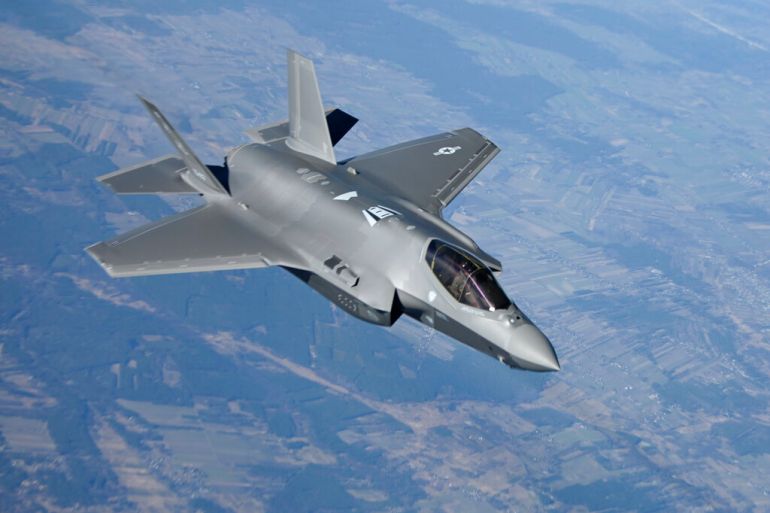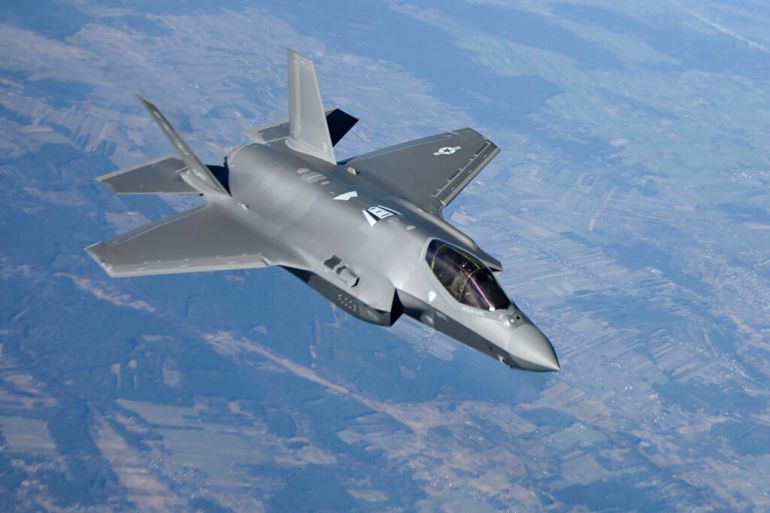What is the F-35 fighter jet, and why does Saudi Arabia want it?
As Saudi Crown Prince Mohammed bin Salman visits the US, we take a look at the fighter jet his country wants to buy.

 Published On 18 Nov 202518 Nov 2025
Published On 18 Nov 202518 Nov 2025
Save
Saudi Arabia’s Crown Prince Mohammed bin Salman is visiting the United States, where he has met President Donald Trump at the White House.
The trip – the crown prince’s first since 2018 – is a sign of the strong relationship between Saudi Arabia and the Trump administration.
Recommended Stories
list of 3 itemsend of list
Evidence of that is the planned sale of up to 48 F-35 fighter jets to Saudi Arabia, something the kingdom has been pursuing for years, but which previous US administrations have refused to do – partially because of opposition from Israel.
So why is Saudi Arabia eager to buy the F-35? And why has the US changed its position on the sale? Here’s what you need to know.
What is an F-35?
The F-35 refers to a family of stealth strike fighters manufactured by the US aerospace company Lockheed Martin. Its official website bills the F35 Lightning II – to give the plane its full name – as “The Most Advanced Fighter Jet in the World”.
As a stealth fighter, it is designed to avoid detection by radar and other technologies. It can then use its strike capabilities to attack an enemy’s defences and fighter jets before they have launched, thereby establishing air superiority in any given conflict if successful.
Several countries are partners with the US when it comes to manufacturing F-35s, including Australia, Canada, Italy, Denmark, the Netherlands, Norway and the United Kingdom. They either manufacture certain components of the fighter jets or have facilities where they assemble the jets that their own governments will use.
Advertisement
What are the different kinds of F-35s?
The F-35A is the most common variant, owned by the largest number of countries. It can take off and land on a regular runway. The F-35A’s weapons and fuel are internal, within the jet’s body, to keep its stealth capabilities.
The F-35I “Adir” is a customised F-35A owned by Israel. It includes Israeli-developed technologies to enhance its stealth capabilities, including jamming and decoy systems. It has also been modified with external fuel tanks to enable it to fly longer missions without the need to refuel. Israel has secured US permission to modify the jet’s main operating system to allow the installation of local Israeli weapons.
The F35-B is used by Italy, Japan, Singapore, the UK and the US. It is capable of landing like a helicopter and taking off with very short lead-up, making it a good option for operating out of very short airstrips. Even though it is slightly smaller than the F35-A, it is heavier and has reduced fuel and weapons capacity.
The F35-C is a supersonic, US Navy aircraft used for long-range stealth operations. It is tailored for use on aircraft carriers.

Why are these fighters special?
F-35 manufacturer Lockheed Martin describes the fighter jet as the “most lethal, survivable and connected fighter aircraft in the world”.
Much of the plane’s reputation for air superiority comes from its combination of stealth, advanced sensors and high-speed computing in a single platform.
It is engineered to reduce detection and gather more information on its surroundings than earlier generations of fighter jets, feeding data from a 360-degree camera suite and other sensors directly to the pilot.
For militaries investing in the jet, it represents a significant change in how air power is used – placing less emphasis on speed and more on identifying threats first, sharing that information across the force, and coordinating strikes with other assets.
Who has F-35s?

Why does Saudi Arabia want them?
Saudi Arabia is already a leading buyer of US weapons, and has been for decades. But it has not been able to get into the F-35 programme.
Changing that would allow Saudi Arabia to upgrade its air force and strengthen its position in the Middle East. While relations are currently positive with Iran, Riyadh and Tehran have previously cut off ties and have regarded each other as threats.
Saudi Arabia has also previously fought the Houthi rebels in Yemen. That conflict that has not yet been resolved, and while currently cold, could turn hot again in the next few years.
Advertisement
Will the US sell F-35s to Saudi Arabia?
The US Congress does have the power to reject weapons sales even if they are authorised by the president, and may choose to do so.
But Trump has made his position clear, and reiterated in his appearance with Prince Mohammed in front of the press at the White House on Tuesday that he wanted to go ahead with the sale.
He batted off criticism of Saudi Arabia and the crown prince, particularly over the 2018 killing of Saudi journalist Jamal Khashoggi, which had been a major source of tension between the two countries for years, particularly under the administration of former US President Joe Biden.
And he also notably showed no deference to the “qualitative military edge” US security policy, which holds that Israel should always have more superior weaponry than its Middle Eastern neighbours.
Trump said on Tuesday that Saudi Arabia would have the same F-35s that Israel does, going against decades of policy – even as Riyadh continues to refuse to sign on to the Abraham Accords and officially establish ties with Israel.
